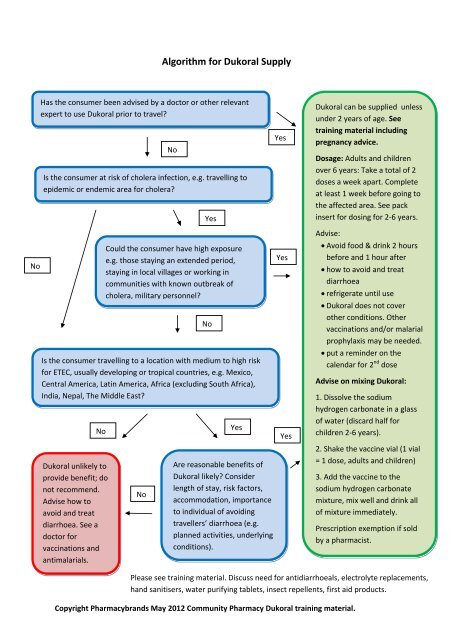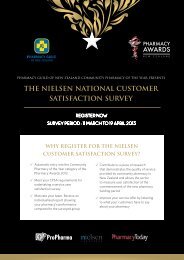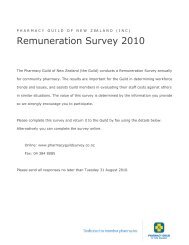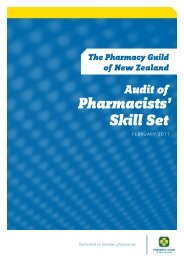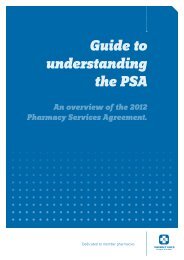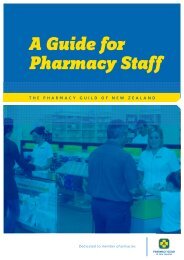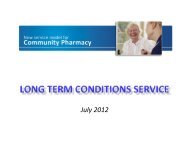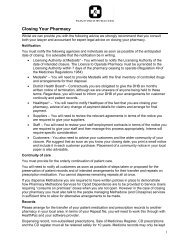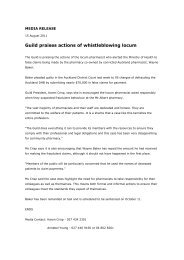Pharmacybrands Final Algorithm for Dukoral Supply May 2012
Pharmacybrands Final Algorithm for Dukoral Supply May 2012
Pharmacybrands Final Algorithm for Dukoral Supply May 2012
Create successful ePaper yourself
Turn your PDF publications into a flip-book with our unique Google optimized e-Paper software.
<strong>Algorithm</strong> <strong>for</strong> <strong>Dukoral</strong> <strong>Supply</strong><br />
Has the consumer been advised by a doctor or other relevant<br />
expert to use <strong>Dukoral</strong> prior to travel?<br />
Is the consumer at risk of cholera infection, e.g. travelling to<br />
epidemic or endemic area <strong>for</strong> cholera?<br />
No<br />
Yes<br />
Yes<br />
<strong>Dukoral</strong> can be supplied unless<br />
under 2 years of age. See<br />
training material including<br />
pregnancy advice.<br />
Dosage: Adults and children<br />
over 6 years: Take a total of 2<br />
doses a week apart. Complete<br />
at least 1 week be<strong>for</strong>e going to<br />
the affected area. See pack<br />
insert <strong>for</strong> dosing <strong>for</strong> 2-6 years.<br />
No<br />
Could the consumer have high exposure<br />
e.g. those staying an extended period,<br />
staying in local villages or working in<br />
communities with known outbreak of<br />
cholera, military personnel?<br />
Is the consumer travelling to a location with medium to high risk<br />
<strong>for</strong> ETEC, usually developing or tropical countries, e.g. Mexico,<br />
Central America, Latin America, Africa (excluding South Africa),<br />
India, Nepal, The Middle East?<br />
No<br />
<strong>Dukoral</strong> unlikely to<br />
provide benefit; do<br />
not recommend.<br />
Advise how to<br />
avoid and treat<br />
diarrhoea. See a<br />
doctor <strong>for</strong><br />
vaccinations and<br />
antimalarials.<br />
No<br />
No<br />
Yes<br />
Are reasonable benefits of<br />
<strong>Dukoral</strong> likely? Consider<br />
length of stay, risk factors,<br />
accommodation, importance<br />
to individual of avoiding<br />
travellers’ diarrhoea (e.g.<br />
planned activities, underlying<br />
conditions).<br />
Yes<br />
Yes<br />
Advise:<br />
Avoid food & drink 2 hours<br />
be<strong>for</strong>e and 1 hour after<br />
how to avoid and treat<br />
diarrhoea<br />
refrigerate until use<br />
<strong>Dukoral</strong> does not cover<br />
other conditions. Other<br />
vaccinations and/or malarial<br />
prophylaxis may be needed.<br />
put a reminder on the<br />
calendar <strong>for</strong> 2 nd dose<br />
Advise on mixing <strong>Dukoral</strong>:<br />
1. Dissolve the sodium<br />
hydrogen carbonate in a glass<br />
of water (discard half <strong>for</strong><br />
children 2-6 years).<br />
2. Shake the vaccine vial (1 vial<br />
= 1 dose, adults and children)<br />
3. Add the vaccine to the<br />
sodium hydrogen carbonate<br />
mixture, mix well and drink all<br />
of mixture immediately.<br />
Prescription exemption if sold<br />
by a pharmacist.<br />
Please see training material. Discuss need <strong>for</strong> antidiarrhoeals, electrolyte replacements,<br />
hand sanitisers, water purifying tablets, insect repellents, first aid products.<br />
Copyright <strong>Pharmacybrands</strong> <strong>May</strong> <strong>2012</strong> Community Pharmacy <strong>Dukoral</strong> training material.
Training Material, <strong>Dukoral</strong> <br />
What is <strong>Dukoral</strong>?<br />
<strong>Dukoral</strong> is an inactivated oral vaccine, consisting of killed whole-cell Vibrio cholera O1 of several<br />
strains (Inaba and Ogawa serotypes, classical and El Tor biotypes) and purified recombinant cholera<br />
B subunit (WC/rBS).<br />
What is <strong>Dukoral</strong> used <strong>for</strong>?<br />
<strong>Dukoral</strong> is indicated <strong>for</strong> active immunisation <strong>for</strong> cholera of adults and children from 2 years of age<br />
with an ongoing or anticipated epidemic or who will be spending an extended period of time in areas<br />
in which cholera infection is a risk.<br />
<strong>Dukoral</strong> is also indicated <strong>for</strong> active immunisation of adults and children from 2 years of age who will<br />
be visiting areas posing a great risk of diarrhoeal illness caused by Enterotoxigenic Escherichia coli<br />
(ETEC). The heat-labile toxin of ETEC (which causes diarrhoea) is similar to cholera toxin – that’s why<br />
<strong>Dukoral</strong> works <strong>for</strong> prevention of both cholera and ETEC.<br />
The World Health Organisation states “vaccination against cholera and ETEC should be<br />
recommended to at-risk travellers.”[1]<br />
ETEC<br />
ETEC is the most common cause of diarrhoea in visitors to developing and tropical countries.<br />
Countries with higher prevalence include Mexico, Central America, Latin America, Africa (excluding<br />
South Africa), India, Nepal and The Middle East. South East Asia has low prevalence of ETEC. There<br />
are other causes of travellers’ diarrhoea, and <strong>Dukoral</strong> is not 100% effective, so ensure consumers are<br />
aware of the need <strong>for</strong> good hygiene practices regardless of whether or not they take <strong>Dukoral</strong> (see<br />
below).<br />
Travellers’ diarrhoea affects 40-90% of travellers depending on their destination.[2-4] While<br />
generally mild and self-limiting, it is inconvenient and risk is highest in those with chronic conditions,<br />
young children, elderly and those who cannot compensate fluid loss such as travellers to high<br />
altitudes.[4]<br />
Enterotoxigenic E coli (ETEC) is the most common cause of diarrhoea in visitors to developing and<br />
tropical countries,[2, 5] responsible <strong>for</strong> nearly half of all cases of travellers’ diarrhoea.[6] There is<br />
regional variability in frequency of causes of travellers’ diarrhoea, <strong>for</strong> example ETEC is thought to be<br />
more common in Latin America than Southeast Asia, but data collection varies between studies and<br />
some in<strong>for</strong>mation is old, from the 1970s.[7] Transmission of ETEC is usually from contaminated food<br />
and water, and infection occurs 10 hours to 3 days after exposure, typically causing profuse watery<br />
diarrhoea sometimes with low grade fever, abdominal cramping and/or vomiting.[8, 9] While ETEC<br />
diarrhoea commonly lasts 4 to 6 days, one study in Nepal found 19% of travellers and expatriates<br />
suffered <strong>for</strong> more than 14 days with ETEC diarrhoea.[4] There are variants of ETEC: the more<br />
common heat-labile toxin producing ETEC (which <strong>Dukoral</strong> protects against)[4] causes an estimated<br />
10 million cases of travellers’ diarrhoea each year;[1] the heat-stable toxin producing ETEC is less<br />
common; and some strains produce both toxins[9].<br />
Copyright <strong>Pharmacybrands</strong> <strong>May</strong> <strong>2012</strong> Community Pharmacy <strong>Dukoral</strong> training material.
<strong>Dukoral</strong> provides protection against the heat-labile toxin-producing ETEC through anti-toxin<br />
immunity rather than through antibodies against bacterial cells; this protection starts 7 days after<br />
the second dose.[4] <strong>Dukoral</strong> provides short-term protection against ETEC diarrhoea of around 50%<br />
regardless of what toxin is produced, and this efficacy rate increases if only heat-labile toxin<br />
producing strains are included.[4]<br />
The Committee to Advise on Tropical Medicine and Travel in Canada suggests the following points<br />
<strong>for</strong> appropriate usage.[10] Because 25-50% of travellers’ diarrhoea is caused by ETEC bacteria, the<br />
protection by the vaccine is approximately 50%, and using the vaccine has the potential to give a<br />
false sense of security (and possibly be less strict on food and water hygiene), using this vaccine <strong>for</strong><br />
travellers’ diarrhoea cannot be routinely recommended <strong>for</strong> most travellers. There<strong>for</strong>e the decision<br />
as to whether or not to use <strong>Dukoral</strong> depends on the individual circumstances. Those at higher risk<br />
are:<br />
<br />
<br />
<br />
<br />
<br />
People with increased risk of serious consequences from travellers’ diarrhoea because of<br />
their chronic illness, such as chronic renal failure, congestive heart failure, insulin-dependent<br />
diabetes mellitus, inflammatory bowel disease<br />
People with increased risk of getting travellers’ diarrhoea, such as young children (over age<br />
of 2 years), or those with low gastric acid (e.g. on proton pump inhibitors)<br />
People who are immunosuppressed<br />
People with a history of repeated severe travellers’ diarrhoea<br />
People <strong>for</strong> whom travellers’ diarrhoea will be particularly difficult to manage, e.g. business<br />
travellers, elite athletes. Although not specifically mentioned by the Canadians, trampers in<br />
remote areas of developing countries are another logical at-risk group,<br />
For these people travellers’ diarrhoea in a developing country is likely to cause considerable<br />
discom<strong>for</strong>t and difficulty in adhering to their travel plans; 30% of Western travellers with travellers’<br />
diarrhoea are confined to their room and 40% have to change their scheduled activities.[4]<br />
Travellers’ diarrhoea is a risk factor <strong>for</strong> irritable bowel syndrome,[5, 11] and can lead to chronic<br />
reactive arthritis.[5]<br />
Treatment of travellers’ diarrhoea is usually rehydration with an antidiarrhoeal if necessary; in some<br />
cases antimicrobial treatment is recommended.[12] Antimicrobial treatment of ETEC is becoming<br />
more difficult due to resistance; resistance to tetracyclines, cotrimoxazole and ampicillin is high and<br />
resistance is occurring even with the quinolones which are currently the preferred antimicrobial<br />
treatment <strong>for</strong> travellers’ diarrhoea.[8] In diarrhoea with frequent watery stools oral antibiotics (and<br />
other medication) may be poorly absorbed due to rapid intestinal transit.[2]<br />
Important points to reiterate with the consumer:<br />
<strong>Dukoral</strong> only reduces the risk of diarrhoea from ETEC and cholera. Good hygiene (see below)<br />
remains vital.<br />
Refer to the doctor 4-6 weeks be<strong>for</strong>e travel to ensure routine vaccinations are up-to-date and<br />
travel vaccinations and/or malarial prophylaxis are covered. See www.who.int/ith/en/ or<br />
http://wwwnc.cdc.gov/travel/page/vaccinations.htm <strong>for</strong> latest travel vaccination requirements.<br />
Copyright <strong>Pharmacybrands</strong> <strong>May</strong> <strong>2012</strong> Community Pharmacy <strong>Dukoral</strong> training material.
Cholera<br />
Cholera is endemic in many countries, e.g. developing countries in Africa and Asia particularly, and<br />
central and South America to a lesser extent, although uncommon in travellers. Risk is higher where<br />
there is overpopulation and/or displaced people and sanitation and drinking water are poor. Check<br />
destination be<strong>for</strong>e travel to see if cholera is a problem (e.g. CDC website<br />
wwwnc.cdc.gov/travel/default.aspx).<br />
<strong>Dukoral</strong> is an effective prophylaxis <strong>for</strong> cholera, a potentially severe GI illness caused by Vibrio<br />
cholerae. It is the only vaccine available internationally <strong>for</strong> cholera and it has WHO<br />
prequalification.[13] The efficacy against cholera is 80-85% <strong>for</strong> the first 6 months according to the<br />
datasheet,[14] although WHO reports 85-90% efficacy at 6 months in all age groups.[13] While<br />
protection averages 63% at three years,[14] efficacy drops over time,[15] thus some sources cite a 2<br />
year protection[4] and the pack insert recommends a booster dose (if risk remains) at 2 years <strong>for</strong><br />
adults, and 6 months <strong>for</strong> children 2-6 years of age. Given that the vaccine does not provide 100%<br />
coverage, all precautions should be taken to avoid consuming or contact with potentially<br />
contaminated food or water, especially in areas affected by the O139 Bengal strain against which<br />
this vaccine is ineffective.[10]<br />
The WHO reports that the seventh cholera pandemic is ongoing, with cholera considered endemic in<br />
many countries (e.g. developing countries in Africa and Asia particularly, and central and South<br />
America to a lesser extent), and with V cholerae remaining in the environment (particularly estuaries<br />
and brackish water) with risk higher during droughts, floods and the rainy season.[13] Cholera is<br />
highly virulent and incubation is 2 hours to 5 days. While death can occur within hours in healthy<br />
adults and children, most cases are asymptomatic[13] and in healthy travellers, cholera often<br />
presents with mild to moderate severity. Thus, the incidence of diarrhoea due to cholera is thought<br />
to be greatly underestimated.[16] People with O type blood group are more vulnerable to severe<br />
illness. Jong (2008) recommends vaccination in more susceptible people.[2] These may include longterm<br />
travellers, those with underlying severe diseases or gastric hypochlorhydria (including from<br />
medication), those in close contact with the local population (including relief, medical and technical<br />
workers), travellers to high-risk destinations or travellers with insufficient access to medical care.[2,<br />
4] A recent review (2008) noted that vaccination of travellers to endemic cholera areas reduces both<br />
their own risk and risk of importing cholera on their return.[4]<br />
Risk factors <strong>for</strong> ETEC and Cholera<br />
Risk factors <strong>for</strong> ETEC and cholera include:[2]<br />
<br />
<br />
<br />
<br />
<br />
<br />
travelling in or prolonged exposure to poor hygiene conditions (e.g. back packers in remote<br />
areas, visitors staying in local villages, aid workers and military personnel)<br />
gastric conditions such as hypochlorhydria (including from gastric acid suppressing<br />
medication such as proton pump inhibitors, H 2 antagonists or frequent antacids) and partial<br />
gastric resection<br />
immune deficiency<br />
poor food handling including poor hygiene in restaurants<br />
drinking unsafe water (including in ice, cleaning teeth)<br />
O type blood group (cholera)<br />
Copyright <strong>Pharmacybrands</strong> <strong>May</strong> <strong>2012</strong> Community Pharmacy <strong>Dukoral</strong> training material.
Risk from fluid loss is increased in advanced or young age, underlying chronic disease and travelling<br />
at high altitude, thus vaccination and avoidance measures may be particularly important in these<br />
groups (noting minimum age of 2 years <strong>for</strong> <strong>Dukoral</strong>). Chronic diseases such as inflammatory bowel<br />
disease and diabetes may be aggravated by travellers’ diarrhoea or cholera.<br />
People taking diuretics need to be especially careful with severe watery diarrhoea and probably<br />
should check with their doctor be<strong>for</strong>e travelling as to preferred action (e.g. stopping diuretic during<br />
diarrhoea and seeking medical advice if more than 1-2 days of severe diarrhoea).[2]<br />
Other travel vaccinations and prophylaxis<br />
Other vaccinations and antimalarials are likely to be needed. The vaccinations required depend on<br />
the travel destination/s. <strong>Dukoral</strong> only provides vaccination <strong>for</strong> some <strong>for</strong>ms of travellers’ diarrhoea,<br />
and other vaccinations are likely to be necessary and may be more appropriate. Advise consumers to<br />
ensure they are up-to-date on routine immunisations as well, such as tetanus and diphtheria. For upto-date<br />
advice on travel vaccinations see:<br />
World Health Organisation (WHO) International Travel and Health. Available <strong>for</strong> downloading at:<br />
http://www.who.int/ith/en/<br />
A map of country requirements <strong>for</strong> yellow fever, rabies and malaria is available at WHO, through<br />
http://www.who.int/ith/en/<br />
Centres <strong>for</strong> Disease Control and Prevention site (in the United States of America):<br />
http://wwwnc.cdc.gov/travel/page/vaccinations.htm<br />
Other travel supplies<br />
<strong>Supply</strong>ing an electrolyte rehydration product, antidiarrhoeal and water purifying tablets <strong>for</strong> travel<br />
would be prudent. Alcohol hand wash may be useful; remind the consumer to wait until the hands<br />
are dry after using alcohol <strong>for</strong> full effect. Insect repellents containing 30% DEET reduce the risk of<br />
mosquito bites, and antimalarial tablets may also be required, depending on area.<br />
Key points <strong>for</strong> avoiding cholera and travellers’ diarrhoea:<br />
Drink and use safe water, even <strong>for</strong> cleaning teeth. Avoid ice unless known to be from safe<br />
water. Use bottled water with intact seals or water purification tablets.<br />
<br />
<br />
<br />
<br />
<br />
<br />
Wash your hands often with soap and safe water, especially be<strong>for</strong>e eating or food<br />
preparation and after using the toilet. Take alcohol-based hand cleaners <strong>for</strong> when soap and<br />
water isn’t available (note: let the hands dry be<strong>for</strong>e eating or touching food).<br />
Use toilets or bury stools 30 metres away from any body of water.<br />
Cook food well and eat it hot. Particularly avoid undercooked or raw shellfish and fish. Boil<br />
it, cook it, peel it or leave it.<br />
Try to use reputable restaurants. Avoid street vendor food.<br />
Wash yourself, your children, clothes and diapers at least 30 metres away from water<br />
sources used <strong>for</strong> drinking.<br />
Be prepared in case of diarrhoea, take oral rehydration sachets.<br />
For further in<strong>for</strong>mation see Safe Food and Water from Centers <strong>for</strong> Disease Control and Prevention<br />
(CDC), http://wwwnc.cdc.gov/travel/page/safe-food-water.htm.<br />
Copyright <strong>Pharmacybrands</strong> <strong>May</strong> <strong>2012</strong> Community Pharmacy <strong>Dukoral</strong> training material.
<strong>Dukoral</strong> Dosage<br />
Dosage <strong>for</strong> ETEC: 2 doses of vaccine in an interval of at least 1 week (no more than 6 weeks).<br />
Complete doses at least 1 week be<strong>for</strong>e travelling to the affected area. See pack insert.<br />
Dosage <strong>for</strong> cholera in adults and children over 6 years: 2 doses.<br />
Dosage <strong>for</strong> cholera in children aged 2-6 years: 3 doses.<br />
Administer doses at intervals of at least a week (no more than 6 weeks apart).[14]<br />
Don’t <strong>for</strong>get to advise the consumer to keep the second dose in the fridge.<br />
Avoid food and drink 2 hours be<strong>for</strong>e and 1 hour after vaccination (otherwise the vaccination may be<br />
less effective).[14]<br />
See datasheet <strong>for</strong> further in<strong>for</strong>mation about boosters.<br />
Precautions<br />
Postpone vaccination in cases of acute illness.[14]<br />
Protection is 80-85% <strong>for</strong> cholera and up to 67% <strong>for</strong> ETEC (short-term); clean hygiene practices are<br />
still required.<br />
<strong>Dukoral</strong> provides protection specific to Vibrio cholerae serogroup O1. Immunisation does not protect<br />
against V. cholerae serogroup O139 or other species of Vibrio.[17]<br />
Limited data is available on immunogenicity and safety of the vaccine in people infected with HIV.<br />
Antibody response may be insufficient in people with immunosuppression.[17]<br />
Trace amounts of <strong>for</strong>maldehyde used in manufacture may be present; care in known<br />
hypersensitivity to <strong>for</strong>maldehyde.[17]<br />
Pregnancy<br />
<strong>Dukoral</strong> is a category B2 drug in pregnancy. According to the NZ datasheet: “The vaccine may be<br />
administered during pregnancy. No specific studies have been conducted to investigate the safety of<br />
<strong>Dukoral</strong> during pregnancy. However, <strong>Dukoral</strong> is an inactivated, non-replicating vaccine given orally<br />
and it is not taken up by the blood stream. It is there<strong>for</strong>e considered to be safe. It has been given to<br />
lactating women in several studies.”[14]<br />
The UK prescribing in<strong>for</strong>mation is more cautious:[17] “No animal data on reproduction toxicity are<br />
available. Following careful benefit/risk assessment the vaccine may be administered during<br />
pregnancy and to breast-feeding women although no specific clinical studies have been per<strong>for</strong>med<br />
to address this issue.”<br />
Travelling to less developed countries carries other risks <strong>for</strong> pregnancy – refer to a doctor.<br />
Adverse Events<br />
The NZ datasheet lists only: upset stomach related to the sodium hydrogen carbonate may occur<br />
occasionally.[14]<br />
Copyright <strong>Pharmacybrands</strong> <strong>May</strong> <strong>2012</strong> Community Pharmacy <strong>Dukoral</strong> training material.
The UK prescribing in<strong>for</strong>mation[17] includes headache (in
17. Crucell Sweden AB. SPC <strong>Dukoral</strong> Oral Cholera Vaccine. 2011 02/2011 16 March <strong>2012</strong>];<br />
Available from: http://www.medicines.org.uk/emc/medicine/14463.<br />
Copyright <strong>Pharmacybrands</strong> <strong>May</strong> <strong>2012</strong> Community Pharmacy <strong>Dukoral</strong> training material.


